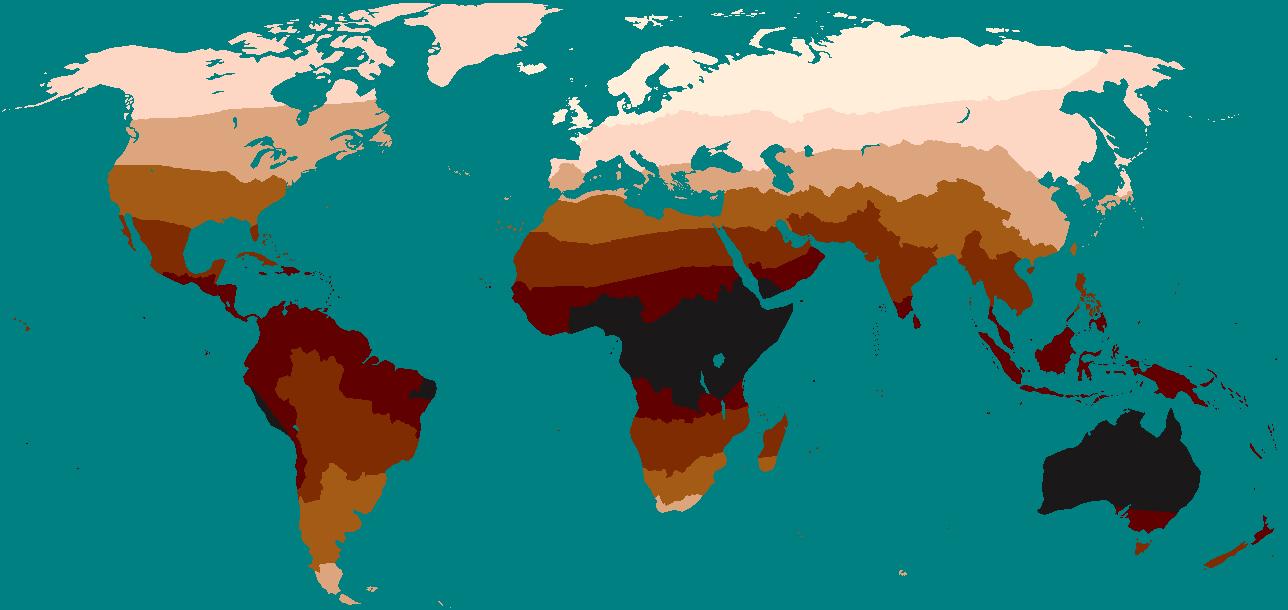Yet the mutations that lightened the skin, probably owing to the need to synthesize vitamin D at latitudes with less solar irradiation, also increase the probability of developing melanoma or skin cancer, which is a negative in natural selection.
In the trade-off of evolution, lighter skin is winning. Saioa López, a researcher at the University of the Basque Country, has studied why this de-pigmentation has taken place and identified two mutations that cause skin to become paler. The work also identified new genes and genetic variants that could be linked to the differences in pigmentation in our population.

Global distribution of skin color. Credit: UPV/EHU
The first hominids that appeared in Africa probably had pale skin covered with hair, like other primates. They are thought to have lost their hair when they became bipedal, and that natural selection subsequently furthered darker skins in Africa as they protect against ultraviolet (UV)light. When humans left Africa (about 100,000 years ago) and headed for Asia or Europe, where UV intensity was lower, they once again acquired a less pigmented skin color. What caused the de-pigmentation of these populations is not clear, and two hypotheses dominate: That it could be due to natural selection that kept skin dark in Africa, since when leaving Africa, UV levels are lower; or that it could be due to the fact that natural selection furthers certain mutations so that individuals can have paler skin, since at these latitudes having a skin with a dark pigmentation prevents the synthesis of adequate levels of vitamin D, essential for our survival.
López, a researcher at the Department of Genetics, Physical Anthropology and Animal Physiology of the UPV/EHU’s Faculty of Science and Technology, has been working to identify the selective pressures that have guided the evolution of this trait, as well as identify new genes and genetic variants responsible for pigmentary differences between individuals. More specifically, the aim was to show that depigmentation has been an adaptive process furthered by natural selection. The methodology used covered a whole host of techniques, including those relating to molecular and cell biology and bio-computing.
Through all this two mutations that functionally cause the lightening of the skin in our population were identified. Highly significant evidence was found to suggest that natural selection is positively furthering these mutations, which are being maintained in the population to produce a paler skin colour. What is more, melanoma samples were analysed and it was observed that these same mutations lead to an increase in susceptibility towards developing melanoma, in other words, the most aggressive, deadly skin cancer.
Why does natural selection further a mutation that causes cancer?
"If natural selection is furthering these mutations that lighten the skin,” explained López, “it is because there has to be some advantage for the individuals, probably enhanced synthesis of vitamin D." Vitamin D can be obtained through the diet but also in an indirect way through a process in the skin in which UV light intervenes.
Dark skins contain a pigment (melanin) that acts as a barrier and prevents UV rays from penetrating. At high latitudes where the intensity of UV light is very low, this is a problem, as insufficient quantities of vitamin D are synthesized.
Vitamin D is essential for skeletal mineralization and development, and the lack of this vitamin can lead to various problems in children’s health. Yet melanoma is a cancer that tends to appear in adult life following the reproductive phase. From the evolutionary point of view, as these adult individuals have by now produced offspring, they are no longer important in evolution.
References:
C. Martínez-Cadenas, S. López, G. Ribas, C. Flores, O. García, A. Sevilla, I. Smith-Zubiaga, J. Gardeazabal, MD. Boyano, A. García de Galdeano, N. Izagirre, C. de la Rúa, S. Alonso (2013). "Simultaneous purifying selection on the ancestral MC1R allele and positive selection on the melanoma-risk allele V60L in South Europeans". Molecular Biology and Evolution, 30: 2654-2665.
S. López, O. García, I. Yurrebaso, C. Flores, M. Acosta-Herrera, H. Chen, J. Gardeazabal, J. María Careaga, MD Boyano, A. Sánchez, JA Ratón-Nieto, A. Sevilla, I. Smith-Zubiaga, A. García de Galdeano, C. Martinez-Cadenas, N. Izagirre, S. de la Rúa C and Alonso (2014). "The Interplay between Natural Selection and Susceptibility to Melanoma on Allele 374F of SLC45A2 Gene in a South European Population". PLoS ONE, 9: e104367
S. López, I. García, I. Smith, A. Sevilla, N. Izagirre, C. de la Rúa, S. Alonso (2014). "Discovery of Copy Number Variants by Multiplex Amplifiable Probe Hybridization (MAPH) in candidate pigmentation genes". Annals of Human Biology.
Source: University of the Basque Country






Comments